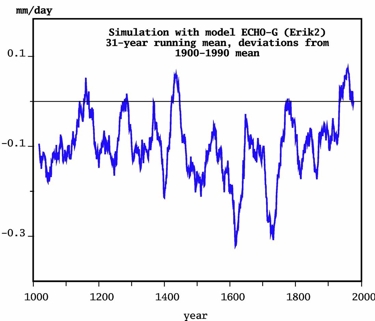|
Precipitation in the Past Millennium in Europe (PRIME) Principal Investigators: Jürg Luterbacher (University of Giessen), Eduardo Zorita (GKSS Research Centre Geesthacht)
Winter (December-February) precipitation anomalies (with respect to the 1900-1990 average) over the past millennium simulated with the ECHO-G model driven by past variations of solar activity, a representation of volcanic eruptions and atmospheric concentrations of greenhouse trace gases. The model simulates lower winter precipitation than present through the whole millennium. Comparison with proxy reconstructions will test these and other simulated results
Simulations of the effect of increasing anthropogenic climate forcing on future precipitation changes still display a large degree of uncertainty due to the lack of agreement among different climate models. This is especially true regarding possible changes in regional to continental hydrological extreme events at daily to seasonal timescales. To reduce these uncertainties, climate models will be tested by comparing simulations covering the past millennium with newly developed hydrologic reconstructions. Sophisticated statistical methods will be applied that assimilate both proxy (documentary, marine and terrestrial) and instrumental data to estimate the probability distribution of all parameters and the climate field through time on a regular spatial grid. The output will include an estimate of the full covariance structure of the hydrologic reconstructions, as well as diagnostic measures that indicate the utility of the different proxy time series for successful reconstruction. Thus, we aim at ascertaining whether global and regional climate simulations are consistent with new proxy-derived hydrological reconstructions, focusing on the spatial patterns of mean precipitation and on the frequency of extremes with associated uncertainties. Over the last millennium the external climate forcing has also undergone variations that may impinge their fingerprints on past hydrological changes, which can be compared to that simulated by climate models. Furthermore, the physical mechanisms leading to slow changes in mean European precipitation and in the frequency of extremes will be jointly analysed in the simulations and using reconstructions of the past large-scale atmospheric circulation. Thereby the fingerprint of the external forcing on the past hydrological changes can be identified in a more robust way. The expected outcome is an evaluation of the model skill in simulating future precipitation changes at continental and regional scale, identification of their deficiencies, and the detection of externally driven precipitation changes, reducing uncertainty for future climate predictions at seasonal and continental scale.
Climate modelling, high-resolution multi proxy records, climate reconstructions
|
| < Prev | Next > |
|---|


